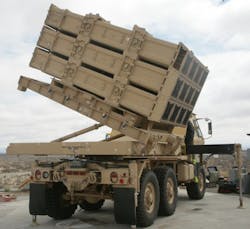U.S. Army engineers prep Multi-Mission Launcher prototype, designed to defeat UAS, missiles, rockets
REDSTONE ARSENAL, Ala., 1 Sept. 2015. Personnel at the Army Aviation and Missile Research, Development, and Engineering Center (AMRDEC) will transfer the first prototype of the Multi-Mission Launcher (MML) to Program Executive Office, Missiles and Space (PEO MS). Both AMRDEC and PEO MS call Redstone Arsenal in Alabama home.
More than 150 subject matter experts, assembled by AMRDEC, with representatives from six directorates and more than 20 functional areas designed, manufactured, procured, assembled, and tested the MML, the U.S. Army’s newest Air Defense launcher. The MML Product Team also leveraged more than 85 industry partners to assist with design and manufacturing.
Army officials are calling the MML prototype “the first development of a major acquisition program by the government in more than 30 years.”
The MML is part of the U.S. Army’s Indirect Fire Protection Capability Increment 2-Intercept (IFPC Inc 2-I) program. IFPC Inc 2-I is a mobile ground-based weapon system designed to defeat unmanned aircraft systems (UAS), cruise missiles, and rockets, artillery, and mortars. The IFPC Inc 2-I system will combine: the MML, the Integrated Air and Missile Defense Battle Command System as the command and control unit, Sentinel radar system, and existing interceptors to provide 360-degree protection with the ability to engage simultaneous threats arriving from different azimuths.
The MML is mounted on a medium tactical truck. The launcher can rotate 360 degrees and elevate from 0-90 degrees. It consists of 15 tubes, each of which can hold either a single large interceptor or multiple smaller interceptors. Developed using an open systems architecture, the launcher will interface to the IBCS Engagement Operations Center via radio. The truck will also pull a trailer that has a missile data link to communicate to interceptors in-flight, and an Army standard 60-kilowatt (kW) generator to power the system while emplaced.
In 2012, the IFPC Inc 2-I Product Office came to the AMRDEC to conduct an engineering feasibility study to support an Analysis of Alternatives excursion for a Multi-Role, Common Launcher. A white paper published in April 2012 concluded that such a launcher was feasible from an engineering standpoint. The launcher groundwork continued with a deeper dive into key performance goals and performance trade studies leading to a Conceptual Design in October 2012. The Conceptual Design leveraged the M1157 Dump Truck, an existing member of the Family of Medium Tactical Vehicles (FMTV), and a M1095 five-ton trailer. The FMTV frame reinforcements, cradle, and azimuth geared bearing were leveraged from the M142 High Mobility Artillery Rocket System along with significant hardware and software architecture experience from AMRDEC engineers.
In March 2014, IFPC Inc 2-I received an Acquisition Decision Memorandum approval to proceed with the AMRDEC development and demonstration of two prototype launchers for the Technology Maturation and Risk Reduction acquisition phase. On 3 Sept. 2015, AMRDEC will deliver the first of two prototype MMLs in 18 months, on schedule and on budget. The second MML will be delivered on schedule on 22 Oct. 2015.
The launchers will demonstrate a Technology Readiness Level (TRL) 6 at the Engineering Demonstration to be held at White Sands Missile Range in March 2016. AMRDEC will provide eight additional MMLs through the Engineering and Manufacturing Development acquisition phase, six of which will be assembled by Letterkenny Army Depot.
AMRDEC is part of the U.S. Army Research, Development, and Engineering Command (RDECOM), which develops technology and engineering solutions for America's soldiers. AMRDEC employs nearly 11,000 civilian scientists, researchers, and engineers.
RDECOM is a major subordinate command of the U.S. Army Materiel Command (AMC), the Army's provider of materiel readiness -- technology, acquisition support, materiel development, logistics power projection, and sustainment -- to the total force, across the spectrum of joint military operations.
PEO MS provides centralized management for all Army air and missile defense and tactical missile programs as well as selected Army Space programs. The PEO is responsible for the full life-cycle management of assigned programs.

Courtney E. Howard | Chief Editor, Intelligent Aerospace
Courtney enjoys writing about all things high-tech in PennWell’s burgeoning Aerospace and Defense Group, which encompasses Intelligent Aerospace and Military & Aerospace Electronics. She’s also a self-proclaimed social-media maven, mil-aero nerd, and avid avionics and space geek. Connect with Courtney at [email protected], @coho on Twitter, on LinkedIn, and on Google+.


